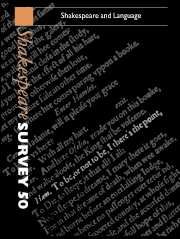Book contents
- Frontmatter
- Shakespeare’s Language and the Language of Shakespeare’s Time
- ‘I’ll plague thee for that word’: Language, Performance, and Communicable Disease
- The Language of the Spectator
- Marlowe’s Edward II: Penetrating Language in Shakespeare’s Richard II
- Hamlet’s Ear
- Secrecy and Gossip in Twelfth Night
- Shakespeare Rewriting Ovid: Olivia’s Interview with Viola and the Narcissus Myth
- ‘Voice Potential’: Language and Symbolic Capital in Othello
- Household Words: Macbeth and the Failure of Spectacle
- Erring and Straying Like Lost Sheep: The Winter’s Tale and The Comedy of Errors
- The ‘Shakespearian Gap’ in French
- Reading the Early Modern Text
- Shakespeare and the Metamorphosis of the Pentameter
- Rereading Illustrations of the English Stage
- Nietzsche’s Hamlet
- ‘Strange and woonderfull syghts’: The Tempest and the Discourses of Monstrosity
- Shakespeare Performances in England, 1996
- Professional Shakespeare Productions in the British Isles, January–December 1995
- 1 Critical Studies
- 2 Shakespeare’s Life, Times, and Stage
- 3 Editions and Textual Studies
- Books Received
- Index
Marlowe’s Edward II: Penetrating Language in Shakespeare’s Richard II
Published online by Cambridge University Press: 28 March 2007
- Frontmatter
- Shakespeare’s Language and the Language of Shakespeare’s Time
- ‘I’ll plague thee for that word’: Language, Performance, and Communicable Disease
- The Language of the Spectator
- Marlowe’s Edward II: Penetrating Language in Shakespeare’s Richard II
- Hamlet’s Ear
- Secrecy and Gossip in Twelfth Night
- Shakespeare Rewriting Ovid: Olivia’s Interview with Viola and the Narcissus Myth
- ‘Voice Potential’: Language and Symbolic Capital in Othello
- Household Words: Macbeth and the Failure of Spectacle
- Erring and Straying Like Lost Sheep: The Winter’s Tale and The Comedy of Errors
- The ‘Shakespearian Gap’ in French
- Reading the Early Modern Text
- Shakespeare and the Metamorphosis of the Pentameter
- Rereading Illustrations of the English Stage
- Nietzsche’s Hamlet
- ‘Strange and woonderfull syghts’: The Tempest and the Discourses of Monstrosity
- Shakespeare Performances in England, 1996
- Professional Shakespeare Productions in the British Isles, January–December 1995
- 1 Critical Studies
- 2 Shakespeare’s Life, Times, and Stage
- 3 Editions and Textual Studies
- Books Received
- Index
Summary
In an often-quoted judgement, Charles Lamb noted that Shakespeare’s Richard II took hints from, but ‘scarce improved’ on, ‘the reluctant pangs of abdicating Royalty’ in Marlowe’s Edward II. But was Shakespeare in fact trying to ‘improve’ on Marlowe when he created his own ‘weak king’ in Richard II? Or was he doing something else? This paper re-examines Shakespeare’s play as a more complicated response to Edward II that reveals dynamic tensions between the two playwrights. Bertolt Brecht’s modern response to Marlowe in his 1922 Edward II provides a useful introductory comparison. Brecht seems to have been drawn to Marlowe’s play not so much for its political as for its personal relevance, in particular for its portrayal of the doomed bond between Edward and Gaveston – the kind of bond Brecht had just written about in The Jungle. Brecht was indeed trying to improve on, or at least to outdo, Marlowe’s bleak play. With a ‘savage pessimism’, he rewrote Marlowe to create a world where, as his Edward says, ‘There is nothing in life besides the touch of men’s bodies, and even that is minimal and vain.’ What interests me about Brecht’s play however is that it is not only about the difficult closeness between two men but – as adaptation, collaboration, and partly cribbed translation – it is also the product of such closeness. Edward II was the first of the collaborative ventures that were to serve Brecht so effectively as catalysts for creativity throughout his career.
- Type
- Chapter
- Information
- Shakespeare Survey , pp. 41 - 56Publisher: Cambridge University PressPrint publication year: 1997
- 2
- Cited by



